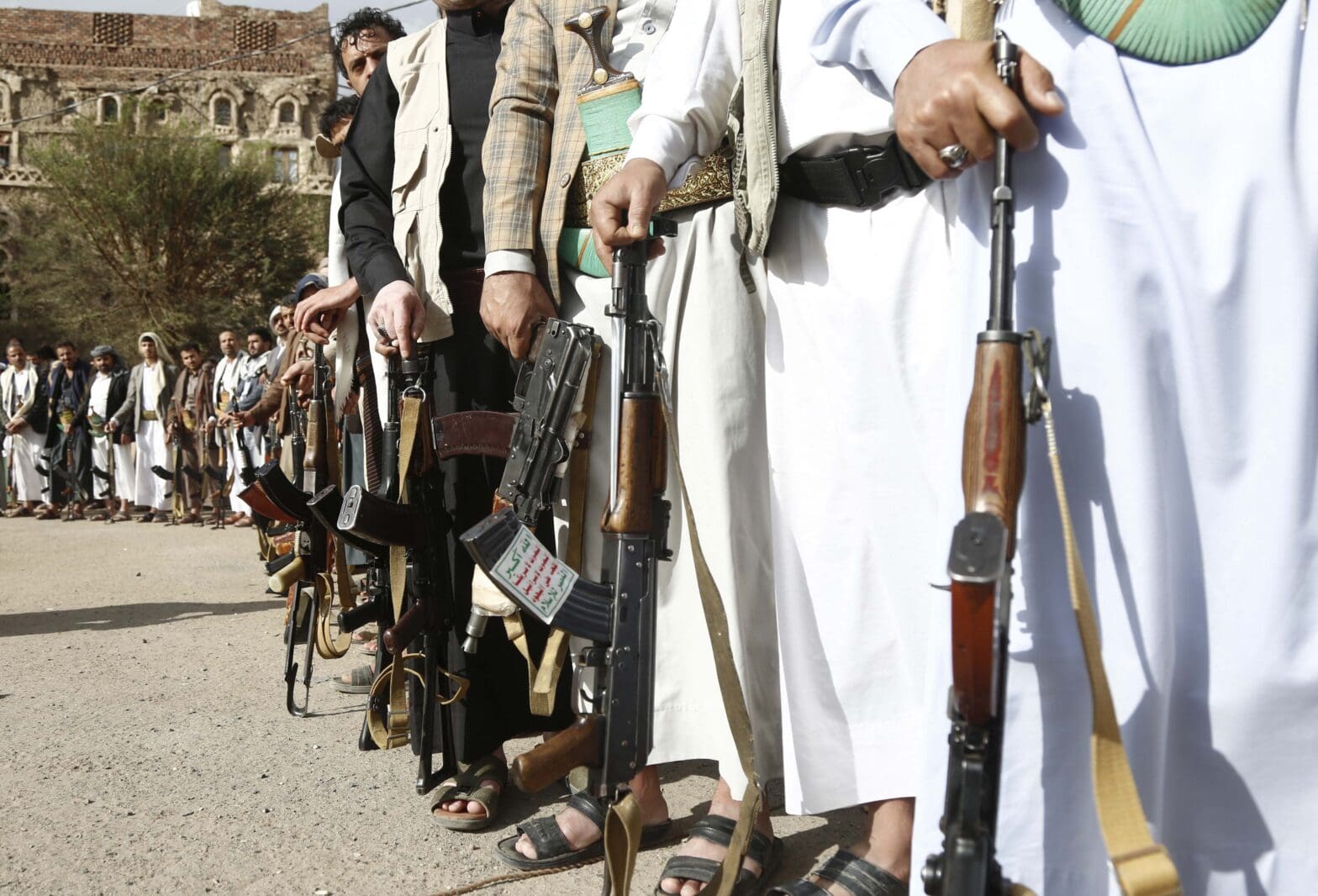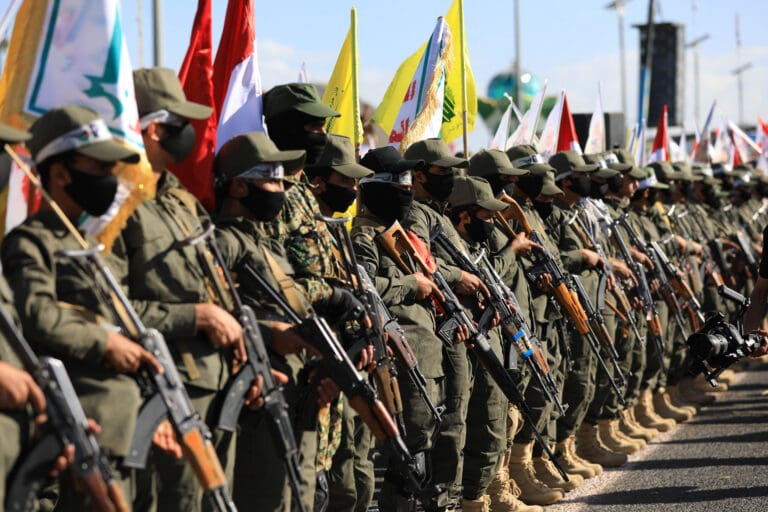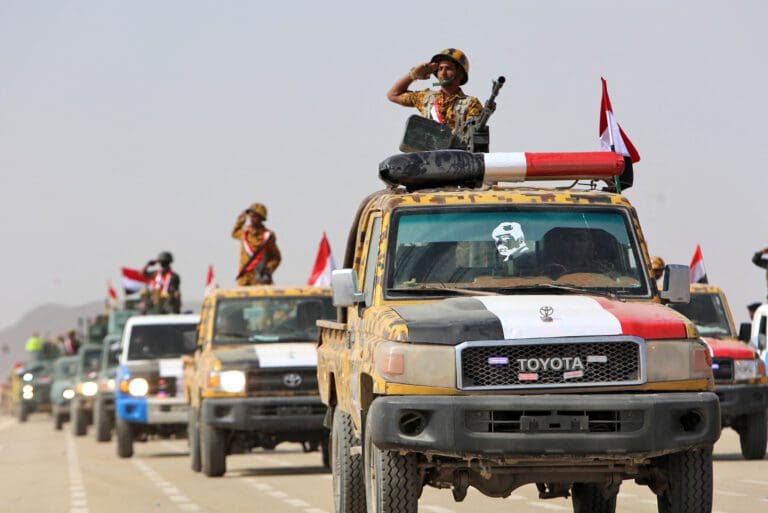
Yemen’s Quagmire:
Why Isn’t U.S. Might Winning?
Policy Note, July 2025
The Red Sea has been at the center of a radical shift in the global maritime security landscape since October 2023, when Yemen’s Houthis (also known as Ansar Allah) launched a campaign of repeated attacks on commercial and military vessels in one of the world’s most important waterways. These attacks, which the Houthis announced were in solidarity with Palestinians in Gaza, have caused unprecedented disruptions to global trade, forcing major shipping companies to reroute and resulting in a 250% increase in shipping costs, threatening global supply chains.1
The Houthis control approximately a quarter of Yemeni territory, including the densely populated northern and western areas, as well as long stretches of the western coast and most of Yemen’s Red Sea islands.2 This control of the western seaboard gives the group a strategic position that allows it to disrupt maritime traffic through the Red Sea. The Houthis’ military capabilities have developed significantly over years of conflict in Yemen, particularly their arsenal of ballistic missiles and drones. Iranian support, both direct and indirect, has further enhanced these capabilities, and the Houthis have also been able to develop a robust domestic military industry, supported by materials smuggled from Iran, despite an arms embargo against the movement.
In response to this threat, in December 2023 the United States launched Operation Prosperity Guardian, a multinational naval mission aimed at protecting merchant shipping passing through the Red Sea. As Houthi attacks continued into January 2024, the U.S. and the United Kingdom escalated their military response, launching a wave of airstrikes against Houthi positions in Yemen. In March 2025, the administration of President Donald Trump launched a large-scale military operation against the Houthis, dubbed Operation Rough Rider.3
The group continued attacking ships in the Red Sea, where maritime traffic remained vulnerable to disruption, raising fundamental doubts over the efficacy of the U.S. strategy and questions over why it had failed to achieve its stated objectives. In May 2025, President Trump abruptly announced a ceasefire agreement with the Houthis, brokered by international mediators. However, Israel was not party to the accord, again posing questions over the nature of the U.S.-Houthi confrontation and the likely consequences.
Despite extensive efforts, which included 931 airstrikes against the Houthis and came at a cost of nearly $7 billion, the U.S. failed to deter or eliminate the group.4 This failure owed largely to three reasons: Firstly, the multidimensional geopolitical complexities in the Middle East; secondly, the evolution of the Houthis’ asymmetric warfare capabilities and tactics, which neutered American military superiority, notably though the deployment of low-cost drones and rudimentary missiles; and thirdly, the structural constraints facing the U.S.—first and foremost, its fear of getting embroiled in a land conflict.5
This policy note addresses this contemporary issue with its intertwined strategic, economic, and geopolitical dimensions, which affect global maritime security, international trade, and regional balances in the Middle East. An examination of why the world’s sole superpower has failed in its confrontation with a non-state armed group offers important lessons on the nature of contemporary conflicts and the limits of conventional military power in confronting unconventional threats in the 21st century.
The Houthi’s Evolving Methods: Phases and Tactics
During the first phase of the conflict, which extended from October to November 2023, the Houthis began carrying out attacks on a limited scale, primarily targeting Israel and vessels linked to it. The hijacking of the Galaxy Leader on November 19 marked a turning point, as it demonstrated the Houthis’ ability to carry out complex operations deep in the Red Sea. This phase was marked by the movement’s use of Al-Mandab-2 anti-ship cruise missiles and suicide drones; there is evidence that these weapons were developed with Iranian support, and that their design and operation rely on technologies similar to those used in attacks on oil facilities in Saudi Arabia in 2019.6
The second phase (December 2023-January 2024) witnessed a significant expansion in the scope of Houthi operations, which now targeted all vessels bound for Israel, regardless of their nationality or ownership. This shift of strategy reflected a political escalation on the part of the Houthis, as well as their growing confidence in their military capabilities. During this period, they launched at least 20 attacks on commercial vessels in the Red Sea, some of which suffered major damage as a result.7 The Houthis also launched ballistic missiles toward the Israeli Red Sea port city of Eilat. This prompted the U.S. to launch Operation Prosperity Guardian on December 18, 2023, with the participation of more than 20 countries, to protect freedom of navigation through the Red Sea. This operation included the deployment of warships and reconnaissance aircraft to the region, adding a new dimension to the conflict. The Houthis relied on a strategy of asymmetric warfare, using relatively low-cost weapons such as drones and unmanned surface vehicles (USVs, or drone boats) to significant effect against international forces. This strategy enabled the group to challenge major powers despite its relatively limited resources.8
The third phase of the confrontation, from February–May 2024, was marked by a sharp escalation between the Houthis and their American and British adversaries. The latter now began launching airstrikes against Houthi military sites in Yemen, targeting missile launchers and command and control centers. Military reports indicate that these operations destroyed more than 60 Houthi targets. In response, the group began directly targeting American and British ships.9 Among the most notable incidents during this period was the sinking of the British-linked cargo ship MV Rubymar, while several other vessels were damaged. The Houthis also expanded the scope of their attacks to include the Gulf of Aden, where they fired missiles at the bulk carrier MV True Confidence, killing three sailors. These developments coincided with escalating regional tensions, which prompted U.S. forces to launch airstrikes on Houthi positions in Yemen in response. In response, the Houthis intensified their attacks on commercial and military vessels in the Red Sea, employing new tactics such as mass drone attacks and operations using explosive-laden speedboats.10
In the final phase (June-December 2024), the Houthis staged an unprecedented expansion in the diversity of their attacks, as well as announcing that they would start to coordinate their military operations with Iraqi armed factions loyal to Iran.11 This development indicated a significant strategic shift, particularly as the Houthis’ operations had become part of a broader regional strategy of targeting all vessels with a connection to Israel, including those linked to the U.S. and the UK.
This qualitative shift was accompanied by a Houthi drone attack on Tel Aviv in July 2024, which caused consternation around the world.12 The drone managed to reach a key target the city before being shot down by Israeli air defense systems. Despite doing limited damage, the attack sent a strong message from the Houthis, demonstrating their ability to strike deep inside Israel. This prompted the latter to respond by targeting the Houthi-controlled Yemeni port of Hodeidah. The Houthis then targeted Tel Aviv with what they claimed was a hypersonic rocket—a high-speed missile able to penetrate air defenses. This sparked significant concern among military officials in Israel and beyond, as it highlighted the sophistication of the Houthis’ missile capabilities. Even though Israeli air defenses managed to intercept the missile, the incident led to further escalation.
Indeed, Israel responded to these attacks in July and September 2024 with intensive airstrikes on the port of Hodeidah—one of the most important seaports in Houthi hands—as well as on vital infrastructure in the city. This was a dangerous escalation in the conflict, particularly as the port is a major entry point for humanitarian aid into Yemen. At the same time, the bombing of the port of Hodeidah may have been intended to cut off the Houthis’ supply routes for importing Iranian weapons, which for Israel would be a preemptive step toward degrading the Houthis’ advanced military capabilities. However, the escalation at this stage was closely linked to regional tensions between Israel and both Iran and Hezbollah. Iran is believed to have supplied the Houthis with the advanced missile technology and drones used in the attacks on shipping and on Tel Aviv. The subsequent de-escalation coincided with the truce declared in Gaza in January 2025.13
With these operations, the Houthis have established themselves as a formidable force in the region, to the point where the U.S. and the UK carried out 931 airstrikes on Houthi positions between January 2024 and January 2025. Yet even these strikes failed to deter the group, which continued its attacks following the collapse of the Gaza ceasefire that had been declared in early March.14
Why is U.S. Strategy Failing?
The situation on the ground demonstrates that the U.S. strategy’s failure to repel Houthi attacks in the Red Sea is not due to temporary circumstance or tactical factors, but arises from a set of deep-rooted structural factors, suggesting that it is likely to endure for the foreseeable future. These factors come under three main headings:
The first reason behind the failure of the U.S. strategy lies in regional and international geopolitical complexities. The Houthi question is enmeshed in a complex network of conflicts across the Middle East, most notably the Israeli-Palestinian conflict. The Houthis exploited this entanglement to portray their naval attacks as being in support of Gaza, presenting the U.S. with a difficult dilemma: how to protect global shipping lanes without compromising on its military and political support for Israel. This contradiction has weakened the U.S. diplomatic position and reduced the effectiveness of its strategic toolkit. Hesitation on the part of other actors in the region—particularly Saudi Arabia and the United Arab Emirates—to engage in military operations against the Houthis has exacerbated Washington’s isolation on this issue, rendering Operation Prosperity Guardian a fragile international effort devoid of real political momentum.
On the political and social levels, the Houthis derive their strength from a solid nucleus, rooted in the Yemeni context and reinforced by an effective ideological narrative which has enabled them to consolidate a base of popular support, by linking their operations to the Palestinian cause and presenting themselves as representatives of the “axis of resistance” against Western hegemony. The Houthis have also established cross-border relationships with regional militias, including groups in Iraq and Somalia, which have provided them with additional human and logistical resources and earned them experience in adaption and resiliency.
A second key factor contributing to this failure is the Houthis’ proficiency in asymmetrical warfare. They have been able to transform the Red Sea theater into a successful testing ground for methods of asymmetrical warfare. Using low-cost drones and relatively rudimentary missiles, they have had a major impact on international maritime traffic, forcing global shipping companies such as Maersk to reroute away from the area, despite the presence of the U.S. military. As a consequence, daily transit through the Bab al-Mandab Strait fell by nearly two-thirds between November 2023 and February 2025. Despite U.S. military operations, the Red Sea has continued to be a no-go area for major shipping companies; the CEO of Maersk has noted that military operations were not sufficient to guarantee the safety of commercial vessels.15
Even though the U.S. Navy has shot down some 400 Houthi drones and missiles, the group’s attacks have continued unabated and at times even escalated, resulting in a strategic failure to restore maritime traffic to normal. A report by the Middle East Monitor described the Houthis as having “emerged stronger after surviving over 1,000 airstrikes, casting doubt on U.S. military efficacy.”16 This reflects the reality that military superiority does not necessarily translate into political or battlefield victory against a decentralized, flexible, and ideologically cohesive opponent.
A third and equally significant explanation lies in the structural constraints on U.S. decision-making. U.S. strategy against the Houthis has collided with deep-seated institutional and political factors at the domestic level. Decision-makers fear a slide into a protracted ground conflict reminiscent of those in Iraq and Afghanistan, which restricts their room for maneuver militarily and limits their ability to deploy more decisive means. Furthermore, the use of precision-guided munitions in Operation Rough Rider, launched by the Trump administration in March 2025 and targeting more than 800 Houthi sites, at a cost of over $1 billion, raised concerns among U.S. Indo-Pacific Command officials that strategic stockpiles could be depleted.17 Although the Trump administration has redesignated the Houthis as a terrorist organization and imposed sanctions on their leaders, the group has continued to receive indirect support from Iran and expand its military capabilities.18
In the economic context, Washington failed to take into account the commercial dimension of the Red Sea. Shipping companies’ decisions to withdraw was influenced not only by the Houthi threat, but also by the decline in global demand in light of Trump’s trade policies, making restoring Red Sea navigation a less urgent goal in market calculations. A report by The Economist described the limited ceasefire agreement of May 6, 2025, as a “Faustian bargain,” as it consolidated Houthi control over Yemen rather than restoring maritime stability. The movement’s leader Abdulmalik al-Houthi described the outcome as a “disgraceful American defeat,” reflecting the symbolic and moral shift in the balance of power in the conflict.19
The disintegration of these three factors—geopolitical, military, and structural—on which U.S. strategy in the Red Sea was based, and which entrenches the continuation of this failure unless these security and diplomatic approaches undergo a comprehensive review, appears a more likely scenario than a limited tactical success.
Given the complexities of the regional landscape, this policy note emphasizes the need to reformulate a more balanced approach that combines security, political, and humanitarian dimensions, and takes into account the realities on the ground. As such, we propose two feasible strategic directions. However, formulating a realistic and effective strategy will require recognizing the limits of conventional power and directing efforts toward incremental, multi-tool solutions that take into account the balance between security and humanitarian stability, and open up a diplomatic track that does not ignore the political realities on the ground:
1. Adopting a smart, effective strategy of containment by building and supporting a unified Yemeni leadership and reducing direct military engagement:
Instead of expanding the scope of its costly military operations, the U.S. could pursue a flexible strategy of containment that focuses on empowering local partners in Yemen and enhancing their defensive capabilities on the ground. To do so, the U.S. must focus its efforts on addressing structural flaws at the command level of forces loyal to Yemen’s internationally recognized government, especially as these forces’ divided loyalties—to Saudi Arabia or the UAE—is one of their main strategic weaknesses. This highlights the need for the U.S. to use its political influence to pressure the two Gulf allies to bring together the Yemeni military leadership in a unified structure. This would improve government forces’ performance in the battlefield, reduce their reliance on foreign interventions, and lay the groundwork for a sustainable national defense apparatus.
2. Isolating the humanitarian track from any political or military escalation, and ensuring aid access:
Given Washington’s designation of the Houthis as a terrorist organization, repeated attacks on the port of Hodeidah, and restrictions on the work of aid organizations, both by the Houthis and due to these organizations’ self-imposed restrictions, Yemen faces the risk of a worsening humanitarian catastrophe, especially since more than two-thirds of the Yemeni population lives in areas under Houthi control. Therefore, the humanitarian track must be separated from military and political considerations, through balanced humanitarian diplomacy that includes the following:
- Establishing a neutral humanitarian coordination mechanism under the auspices of the United Nations, including representatives of relief organizations and local authorities, with the aim of ensuring the exchange of information and determining priorities for non-military interventions.
- Expanding the scope of the work of the UN’s Office for the Coordination of Humanitarian Affairs (OCHA), through flexible funding and a broader political mandate from the UN Security Council that allows it to negotiate directly with all parties and ensure the freedom of movement of convoys and the flow of supplies.
- The provision of conditional humanitarian incentives, such as by facilitating the entry of commercial imports or supporting small development projects in areas that commit to ensuring the freedom of movement of relief workers.
- The establishment of a smart, precise sanctions framework that targets individuals or entities who obstruct humanitarian operations, without impacting the civilian population or restricting the work of international relief agencies.
In light of these realities, there are three possible scenarios for the future of the confrontation. The first and most likely is that the status quo continues, without any fundamental change in the balance of power or the dynamics of the conflict. The second scenario would be a comprehensive U.S. military escalation, possibly leading to ground operations; however, this is less likely given the significant political, economic, and humanitarian obstacles to such a move. The third scenario would involve a comprehensive diplomatic solution to the Yemeni conflict, linked to a settlement of the Israeli-Palestinian conflict. However, while theoretically the optimum outcome, it remains unlikely given the current geopolitical complexities and fundamental clashes between regional and international interests.




